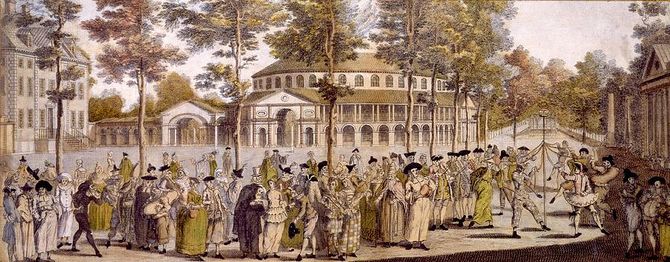Annotation:Trip to the Jubilee (2)
X: 1 T:Trip to the Jubilee [2]. JJo6.84 B:J.Johnson Choice Collection Vol 6, 1751 Z:vmp.Ruairidh Greig 2015 www.village-music-project.org.uk M:2/4 L:1/8 Q:1/4=100 K:Bb F|B>dc>B|f>dB>e|d>cB>A|B2fg/_a/|g>eE>g|f>dD>f|d>BA>B|(Bc2):| |:c|f>ed>c|=B>_AG>F|E>_ag>f|e>dc>d|e>dc>B|A>GF>E|D>ed>g|f>AB>a| b>fd>B|g>ec>B|f>cA>c|B2F2|G>BA>c|B>ed>c|d>BF>A|B4:|

Jubilee masquerade balls were introduced to London in the 1720s, and their glamour and promise of social freedoms drew thousands to the pleasure gardens of Haymarket, Vauxhall and Ranelagh where the events stimulated gender-swapping, class fluidity and intrigue. Criticisms of foreign influence and hedonism eventually suppressed them, and by 1751 the Bishop of London had acquired a temporary ban on public masquerades. Despite this jubilee events continued (in somewhat more subdued fashion). Some of the more famous jubilees in 18th century London were in celebration of the the birthday of George, Prince of Wales, May 24th, 1759, and the Jubilee Venetian Masquerade Ball in Ranelagh Gardens, Chelsea, London, 1749.

